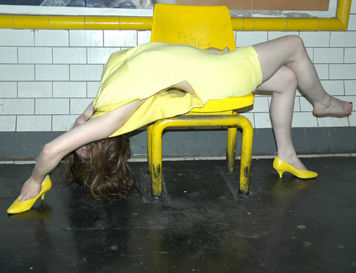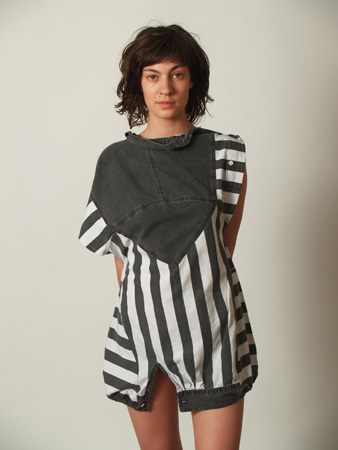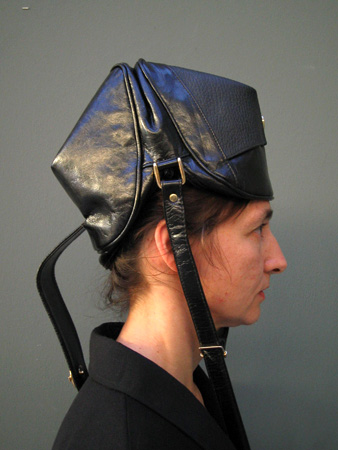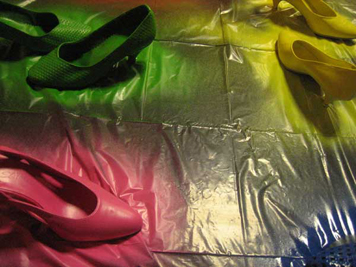
Marianne Maric, from the series Subway, Models: Charline et Christelle
Provocative gestures in fashion tend to be slight or sensationalistic or cloying. Perhaps because fashion as a medium is simultaneously open to anything and completely circumscribed, attempts to be transgressive always seem to fall a bit flat: it's always a shirt, and if it moves "beyond" being a shirt, then it's just a costume. These limitations don't make experimentation completely futile but they require moving beyond formal experimentation. Parisian Art/Design collective Andrea Crews does just that by exploring the garment as a set of social, economic and ethical choices.

Andrea Crews, blouse from Summer 07 collection
Andrea Crews' primary medium is recycled or "post-vintage" clothing. Crews transforms discarded clothing and dead stock into one-of-a-kind apparel items. But this is not so unique. Vendors like Urban Renewal have been doing this for decades. What makes Crews' work interesting is that they also devote time to projects like turning purses into hats — by simply putting them on people's heads. A project like this takes something completely ordinary and familiar and legitimately raises the question, "What is this thing?" This kind of experimentation plays with meaning rather than form, but at the same time it generates some plausible formal ideas.

Bilbao Modorrra, ready made: Voin de Voin, photo by Maroussia Rebecq
In another project Crews takes a bunch of used high-heels and spray paints them bright colors to create a "new" line. Far from being a send-up, the gesture celebrates the superficial nature of fashion. A little color can bring together a bunch of disparate, old, and discarded things — How wonderful! At the same time of course the gesture raises questions about the reification of something as simple and human as style. Why is it so expensive? Why is it industrialized? Why is it so exclusive? But these questions aren't overbearing, they are just tucked away in the gleeful realization that style is simply a layer applied to the everyday.

Andrea Crews, Shoes, photo by Maroussia Rebecq
Andrea Crews work in a grey area between Art and Fashion that was largely mapped out by Chicks on Speed. CoS are...a...band? A group of artists? Fashion designers? It's confusing and intentionally so. The group was formed in 2002 and since then they have consistently released records and performed live as a conventional band might. But at the same time the group has carried out a series of low-tech artistic interventions into the worlds of fashion and retail.

Chicks on Speed
Chicks on Speed's first publication, It's a Project, contained patterns for do-it-yourself versions of their signature overalls. They collaborated with designer Jeremy Scott on more of these "overalls for all." The Paris depatartment store Le Bon Marche gave the Chicks clothes which they cut up, reassembled and modeled in the store's windows. Band-member Melissa Logan calls it, "The most perfect product made even more perfect by taking the mass out of the produced."

Sex, shop run by Vivienne Westwood and Malcolm McLaren previously called Seditionaries, Let It Rock, and Too Fast to Live Too Young to Die, 1974
Both the Chicks on Speed and Andrea Crews owe a great debt to the work of Vivienne Westwood and Malcolm McLaren. But they are not punk. They are not engaged in the practice of negation. Perhaps that kind of posture isn't even possible any more. Punk is a word whose meaning has been thoroughly diluted. MacLaren and Westwood constantly shifted the name and merchandising of their store in Chelsea to go against the prevailing culture. But Crews and CoS work within the vocabulary of the mainstream. Even the name Andrea Crews embodies this critical stance, accepting the fashion industry norm where multinational corporations masquerade as individuals. Is Andrea Crews any less real than Ralph Lauren? The Crews website reads, "More than a brand: Andrea Crews is a new concept which proposes a fair and equitable model of production, an alternative to the current consumer system." Instead of constantly seeking or manufacturing newness, Crews proposes renewing what is already around us.


Comments [19]
Dimitri, if you Google the following names; you will see that which you so breathlessly ascribe as being unique, is another iteration in a long line of (at times petty) surrealism.
1. Elsa Schiaparelli's hat that looked like a shoe, done in the 1930's.
2. Jean-Paul Gaultier
3. Victor & Rolf
You could also point to various one-of items like Alexander Calder's home-made neckties or the sheet-metal dresses in William Klein's "Qui êtes-vous, Polly Maggoo?"
And that photo at the beginning of your post? Very Guy Bourdin.
Get thee to a Googlery!
06.04.07
03:37
Thank you m.kingsley.
06.04.07
09:12
I'm reminded of the old cliche of the guy who gets drunk at a party and staggers about with a lampshade on his head. It's probably funny to the other drunk people at the party. The lampshade wearer wasn't playing with meaning and form--Is it a lampshade or a hat? Oh my, how provocative!--he was just drunk! Furthermore, he was playing to a like-minded audience, entertaining other drunks with silly, self-indulgent behavior. Which, later on--or to sober party goers--probably just looked pitiful. And that's exactly how this work comes off. It's playing mostly to the self indulgent, self absorbed world of fashion. Like so much "art" that tries so very hard to be intentionally provocative, it falls flat and merely looks like a boring insider's joke.
Even more ridiculous would be if the party drunk later tried to sell his lampshade for 90 Euros on his web site! And that's exactly what Andrea Crews is doing with her (their?) spray painted used shoes. So it's a social and ethical choice? I doubt it. But it IS certainly an economic one. I wonder how much it cost Andrea Crews to make these shoes? I'll bet she (they?) is/are making--or hope to make--a tidy profit from their self conscious little gimmick. Actually, it's pretty brilliant: Repackaging cheap cast offs as expensive fashion items. But this is hardly the first time anyone has tried it. The obvious profit motive pretty much negates their pretentious social/artistic manifesto.
I recommend that anybody who is intrigued by the social, ethical and economic choices of this drivel simply go to their local Goodwill and buy some old shoes, then go to their local Home Depot and buy some spray paint. Even better, they could skip the spray paint since it's an environmental hazard. In the end, they'll have themselves some responsible footwear AND will have saved themselves $70 or so--which they can then give to their favorite worthwhile charity, or even just invest in their own personal savings. Either of which would be a far more legitimate social, economic, and ethical choice.
06.04.07
10:32
06.04.07
11:01
06.04.07
01:04
06.04.07
03:03
Now let's all get drunk and wear lampshades!
06.04.07
03:40
Schiapaerellis' hat looked like a shoe -- it wasn't a shoe. I would think someone who references Shakespeare with such self-satisfaction would be able to recognize the difference. (With our without the help of google).
Victor & Rolf and Gaultier would rather impale themselves than rehab anything, especially someone else's old shoes. All the examples you cite are people who produce surrealist or formally inventive designs within the established fashion industrial model. Just because they make flamboyant garments doesn't mean they are relevant here. CoS and Westwood are relevant because they share an ethos.
06.04.07
04:28
My general view of criticism's role includes the placing of work within context. Besides the examples I offer above, contextualizing Andrea Crews against other examples -- like Rei Kawakubo's Comme des Garçons; Imitation of Christ; Issey Miyake; or even the multitude of lesser-known lines available in the smaller boutiques of the Lower East Side, the 5th and 6th Arrondissements, or East Berlin -- one could come to a conclusion that didn't seem like a press release (to paraphrase Rob Henning).
In fact, if you ever get a chance to see David Teboul's film "Yves Saint Laurent 5 avenue Marceau 75116 Paris," the astonishing level of detail that went into his work -- the ongoing exploration of what a garment is: the critique of how fabric falls on the body, the physicality of folds over the volume of the body, etc. -- certainly places Andrea Crews in a much more satirical and ridiculous place than the hallowed "what is this thing?" ground of Dmitri's post.
Google is a tool; nothing more. But given that Design Observer's charter includes Design and Culture, and that comments are allowed; consider me simply as an editor demanding deeper inquiry and greater insight. That particular mindset plus Google is of greater value.
By the way, Thurman's good; but Roland Barthes, Umberto Eco and the Washington Post's Robin Givhan on fashion are best.
06.04.07
04:58
Furthermore, has anyone ever actually seen a drunk in a lampshade? (Oh, how I wish I had!) Given the cliched nature of the image, even the drunkiest of drunks would be likely be aware of the ironic implications. And so it would be nearly impossible for a lampshade to be worn naively -- without it being a winking work of art.
06.04.07
05:07
Also, your realization (through Crews' recolored shoes) that style is simply a layer applied to the everyday is a line crossed every time one sees, for example, a Stephen Sprouse-graffitied Louis Vuitton bag or a silk-screened piece by Libertine.
06.04.07
05:19
Jessica's defense of this post seems so thin and half-hearted that I sense she understands the threat to credibility when a limited designer/writer runs afield of his subject expertise. Clearly he should be offering more than, as observed by Rob,"...something Crews' PR agent might have written."
I originally visited DO because I thought there might be some potential for cross fertilization of design knowledge between areas of design expertise. MB's posters for Yale were always a source of inspiration, albeit in an entirely different but related field. To date I have found neither the expertise nor the curiosita for such an exchange.
06.04.07
06:48
06.04.07
08:58
And the leggy girl with stripes above her, HOT!
Thanks D.
VR/
06.05.07
01:15
Hear, Hear!
06.05.07
09:45
06.05.07
11:07
The most annoying aspects of this post is how little the writter actually delves into fashion. Seeing as this is the CONTEXT that the Andrea Crews collective is trying to place themselves within there is little real discussion around that topic. The only real nod being towards the British Shop Let It Rock/Too Fast to Live, To Young to Die/Sex/Sedientaires. However, with the Westwood Collection currently touring one only needs to scratch the surface to see that Ms. Westwood was not merely about negating what was out there. Ms. Westwood was questioning and repositioning herself (and Mr. Mclaren) in a new way. Fashion has as much theory circling round that to just say Ms. Westwood was merely about negation does not acknowlege her true talents.
Much like the modern fashion lines that change direction every season they applied that sort of thinking to comodity and to retail environments. They were making social commentary on the current British social and polictical landscapes. Creating responses to that with every season (Rockabilly is to work force as Punk is to classism, S&M is to restrictions, New Romantic is to new world order, etc.) To compare what Crews is doing to Westwood et all is laughable at best.
What Crews Collective is doing is not new - certainly not in the art scene and certainly not in the fashion scene. Especially with the slant of the socio and political. Junky Styling, Meat Locker and This Old Thing (to name a few) have been asking people to re-examine cast-offs, social order, and the fashion machine but don't have the press department and the French Avant Garde behind them.
I think this article is an interesting moment of someone outside of the fashion scene looking in to the world. Informative and "new"? Hardly. If DO really wants to post about fashion make sure you have a full understanding about it before you start making commentary about "groundbreaking."
06.05.07
11:29
Everyone knows that clothing speaks volumes even if you never open your mouth; we all know that how we dress inevitably lumps us into certain categories, making it obvious that garment choices represent social choices and identifications. But I'd be interested in deconstructing what that means ethically and epistemologically.
Why do we wear what we wear? Certainly our fashion decisions are based on many factors: weather, physical comfort, aesthetic... But what about less obvious reasons, such as social expectations? What are we doing for ourselves and for members of our self-identified communities (co-religionists, colleagues, members of our ethnic groups, etc.) when we deliberately choose fashions that are unexpected? What stereotypes do we challenge? What are we saying in our choices? How much of our self-identification is linked to communal fashion decisions, and how important are those identifications to us? How do they affect how we dress? Would we make the same choices if our peers didn't? Should it matter?
On first glance it seems superficial and meaningless. After all, good lord, it's just clothing! But it's also how we are seen, immediately. And to that end, it's significant.
06.05.07
03:17
Dmitri, I'm afraid I do have to say this does almost read like a PR document. The purse on the head somehow reminds me of Duchamp's work, or the dada movement, but it legitimately questions meaning? In 2007? How? Yes maybe it does, but please may you elaborate more on that? It does not interest me in the work because it's not convincing me to investigate further - on the contrary it gave me a gut reaction that this work is pretentious - but hang on, is it really the work, or is it just what I'm reading?
That is dangerous. I do not want to judge someone's work by what was written about it on a blog. I'm not saying that everyone's got to write academically, proper footnotes never existed on blogs as I'm aware, yet as much as an authority DO has become, I'm concerned that I expect posts to be written with more in depth consideration.
06.09.07
10:19